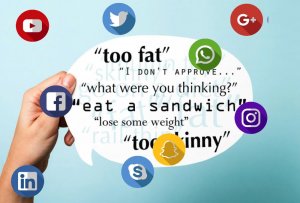Starving for Social Approval:
This blog explores how social media distorts ideas of healthy eating habits for young children through virtual platforms by bombarding them with unrealistic images of the ideal body type.
Written by: Chelsea Dowler, COTA/L

The Trend of Social Media
Humans live in a world driven by the content and gratification that we receive through social media platforms. Okay, maybe not everyone; however, recent numbers indicate close to 3.9 billion people use social media worldwide which includes 80% of North America. Unfortunately, the consumers of social media do not control the messages being broadcasted through these virtual platforms. Beauty-related thinness is a trend that has been around for ages. In the 1960s the well-known actress/model “Twiggy” was iconic for having the ideal thin body shape that influenced women all over the world. At 16 years old she displayed an anorexic image that became known all over the world with her rise in media influence (Bittar, 2020). During these times, traditional media was observed by the older population while family, church, and school influenced the minds of the children. Today, teens are the dominant users of social media platforms across the board, however, the supervision of social media use for the age group has diminished. Due to the increase in independence in adolescences, a rise in inappropriate eating behaviors seems to accompany this freedom that often is skewed by the media they consume.
Why should we care?
You might be thinking, “Why is this?”, and though we have all seen the commercials for weight loss pills and quick-fix diets, however, studies have identified that over half the information provided promoting these items are false and unsustainable claims. In the media today, these false claims are affecting children, many of whom are vulnerable and susceptible to believing that the dreamy “ideal thin body” can be achieved in just a few simple ways. This leads to a downward spiral of chasing a goal that is unrealistic for the average person and promotes a negative self-image and reduces overall confidence.
What is an eating disorder?
An eating disorder is a mild-sever illness that is characterized by several disturbances in their eating behaviors as well as related thoughts and emotions (Parekh, 2017). Many individuals who experience this illness become obsessive and occupied with their food consumption and their body weight. The 3 main types of eating disorders include anorexia nervosa, bulimia nervosa, and binge eating disorder and often accompany psychiatric disorders as well.
Anorexia Nervosa: These individuals have a fear of being overweight. It is defined as weighing at least 15% or more below the normal healthy weight for their height. They are unable to maintain their weight looking fragile and unhealthy due to refusal to eat or excessive exercising.
Bulimia Nervosa: Eating excessive amounts of food frequently. They often consume food in private and do not stop eating unless interrupted or they are so full it becomes uncomfortable. After their binge, stomach pain or fear of gaining weight often causes them to purge or vomit. This cycle can happen multiple times a month to even multiple times a day. These individuals can portray various body types which makes it difficult to detect.
Binge Eating Disorder: Out of control eating by consuming a high volume of food in a short amount of time. Unlike Bulimia, these individuals do not try to get rid of the food they consume. These behaviors are chronic and often lead to obesity and other health complications.

Hungry for Likes: The influence of social media on eating behaviors
First impressions are a large part of how the world sees us as individuals, especially through social media platforms. Virtual platforms create a standard of placing appearances above all else including communication which was the original aim of social media creation. Studies are showing a positive correlation between poor eating habits and body changing behaviors to the associated perceptions influenced by social media (Rodgers, 2020). The average age of social media users is much younger than the viewers of traditional media years ago. With this drop in age of the average mainstream users, the age group influenced most by social media has also dropped affecting more children than ever before. Studies show that 12 – 24-year-olds make up the majority group for when eating disorders begin.
Warning signs to look for:
- Sudden changes in eating habits (diets, low calorie or no-carb consumption)
- Extreme amounts of exercise
- Changes in behaviors ( depression, anxiety, etc.)
Influencing Change: How you can impact those with eating disorders
As a parent, friend, sibling, or victim of this unfortunate phenomenon, the first step to change is to begin talking about it. As uncomfortable as it may be, awareness of the situation is key. Start the conversation with an open mind and willingness to understand the influences social media may be playing when it comes to eating behaviors and negative self-image. This will open the doors to other opportunities for discussion and help. A simple conversation can alter or prevent the behaviors from starting.…
- Identify what social media is influencing these thoughts ( Who, what, why?)
- Question and understand the reliability of the content ( Are they fake? Altered? Etc.)
- Limit screen time
- Eliminate triggers for negative self-talk (Who do you follow? What is being posted?)
- Replace time on social media with healthy alternative activities
Your presence matters! As someone important in their life, it is your job to set a good example of what realistic and healthy expectations should look like. Work together to stay aware of what is going on in their life and on their social media. Take the opportunity to embrace their struggle and remember it’s what they are perceiving that influences their decisions. Engage them in healthy alternative activities to decrease social media presence during their day.
Helpful Resources & More Information
NEDA – National Eating Disorder Association (nationaleatingdisorders.org)
ANAD – National Association of Anorexia Nervosa and Associated Disorders (anad.org)
MORE resources: check out http://eatingdisorderhope.com
References:
Bittar, C., & Soares, A. (2020). Media and eating behavior in adolescence. Cadernos Brasileiros de Terapia Ocupacional. 28(1), 291-308. https://doi.org/10.4322/2526-8910.ctoAR1920
Parekh, R. (2017, January). What are eating disorders? Retrieved from https://www.psychiatry.org/patients-families/eating-disorders/what-are-eating-disorders
Rodgers, R. F., Slater, A., Gordon, C. S., Mclean, S. A., Jarman, H. K., & Paxton, S. J. (2020). A biopsychosocial model of social media use and body image concerns, disordered eating, and muscle-building behaviors among adolescent girls and boys. Journal of Youth and Adolescence, 49(2), 399-409. doi:10.1007/s10964-019-01190-0

Hi Chelsea!
Wow, what a great blog post! I found your blog to be very informative. I typically only thought about how social media can potentially impact a teens mental health in a negative way. But it is very interesting to think about how social media can influence eating habits in order to achieve that “ideal look” among adolescents. Your overall blog offered great information, effective media clips, and was appealing to look at. Nice job!
Michele M.
Hey! Your Blog really hits home for me. I am recovered from an eating disorder that took over my life for numerous years. It’s disgusting we are always trying to please society and their unrealistic standards. NEDA is a great organization, I walk in their walk every year when it comes to RI. Your blog was accurate, resourceful, and had great information.
Thank you for choosing this topic, you’re beautiful.